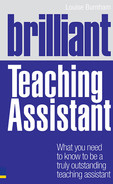Foreword
Teaching assistants play a crucial role in today’s schools. Or, to be more accurate, they play many crucial roles. Their number literally doubled between 2000 and 2010, to 190,000 full-time equivalent jobs – and that’s only in England. There are lots of reasons for this rapid growth, but one of the main causes was the move to free up more teachers’ time for teaching. The Workforce Remodelling Agreement, signed by the government and most education unions in 2003, created the conditions for support staff to take over many non-teaching tasks from teachers – tasks such as preparing classrooms for lessons, making displays and invigilating exams, collecting dinner money and photocopying. Higher Level Teaching Assistant status was introduced so that teaching assistants who could show they had the right skills would be able to take on extra responsibilities, and get a higher rate of pay.
As well as supporting teachers, teaching assistants are also needed in large numbers to support children with special educational needs. David Blunkett, Tony Blair’s first Education Secretary, had painful childhood memories of being sent away to blind school himself and was determined that disabled children should go to mainstream schools. Many of these children need extra support to be able to join in with their classmates’ activities and fully benefit from everything school has to offer.
Whatever the reason, the fact is that most schools now employ several teaching assistants, and most classes now have more than one adult present at least some of the time. Teaching assistants, under the supervision of the teacher, support the learning of hundreds of thousands of pupils every day, individually, in groups, or in whole classes.
Equally importantly, they take care of children’s emotional and social needs. Whether they’re working in the playground or in school, teaching assistants tend to have more one-to-one contact than teachers with individual children, and children look to them for support and comfort with problems at home as well as at school.
Although there are no minimum qualifications for being a teaching assistant, more and more schools want qualified teaching assistants, and there has been a confusing array of qualifications available. The new unit-based Qualification and Credit Framework should mean teaching assistants can build up a qualification at their own pace, and don’t have to spend time studying things they already know.
Nonetheless, even with a qualification, going into a new school as a teaching assistant can be a daunting experience. One of the trickiest challenges is to work out who’s who, and how to build the right relationships with pupils and colleagues alike. Brilliant Teaching Assistant offers plenty of down-to-earth guidance on how schools really work, and where you fit in, and the case studies and examples pose some of the knotty, practical problems a teaching assistant is likely to encounter in the real world. Louise Burnham doesn’t offer simplistic solutions, but by bringing the reader the benefit of her own experience as a TA trainer and a Special Educational Needs Co-ordinator, she’s written a solid and practical introduction for anyone thinking of becoming a teaching assistant, starting a new TA job, or wanting some extra inspiration in their current TA role.
Frances Rickford
Editor
Learning Support magazine
